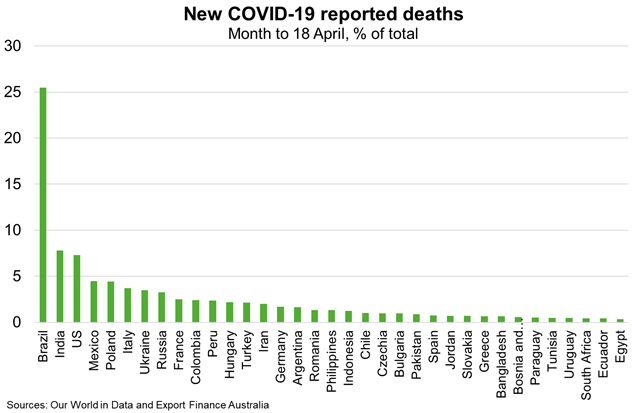Brazil—COVID-19 weighs on economic and political stability
Brazil’s second COVID-19 outbreak has been characterised as a “raging inferno” by WHO officials. While the second wave of the virus appears to have begun decelerating, the average daily death rate remains high, with almost 3,000 deaths per day over the first half of April, more than a quarter of the world’s total (Chart). Health systems in Brazil remain under sustained pressure and the national vaccine program continues to be beset by supply constraints and concerns over the efficacy of vaccines against Brazil’s P1 variant. Supply constraints are forecast to ease from June which could see a much needed acceleration in vaccinations in the second half of the year.
The Senate has launched an inquiry into the handling of the COVID-19 crisis amid criticisms from business and waning support from Congress. President Jair Bolsonaro’s negationist attitude towards the pandemic has been politically costly, with his approval rating falling to 27% in late March according to survey by XP/Ipespe. While a cabinet reshuffle on March 29 should see Congress remain supportive in the near term, policy uncertainty and risks to governability have increased.
Following a 4.1% contraction in 2020, the Brazil’s economy is expected to partly recover in 2021 with growth of 3.7%. The Brazilian government is doubling down on its aggressive infrastructure program to drive Brazil’s post-COVID economic recovery. An ambitious schedule of concession auctions in 2021 is forecast to generate investments of around US$87 billion in roads, rail, ports, airports, telecommunications and mining and energy. Trade, investment and services opportunities for Australian companies are increasing across a range of sectors including infrastructure, energy, mining and agriculture.
Brazil’s economic recovery could be more limited were the public health crisis to deteriorate further and/or the government’s commitment to fiscal discipline and the microeconomic reform agenda wane. This would thwart opportunities in Australia’s largest Latin American export market.

